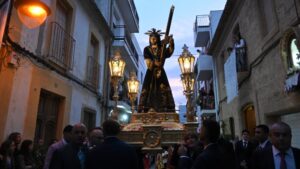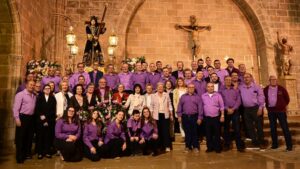Blanca Pons-Sorolla: «Xàbia inspired me to write the biography Joaquín Sorolla, life and work 20 years ago»
XAD collaborator David Gutiérrez Pulido interviews Blanca Pons-Sorolla, Joaquín Sorolla’s great-granddaughter after receiving the Vila de Xàbia award.
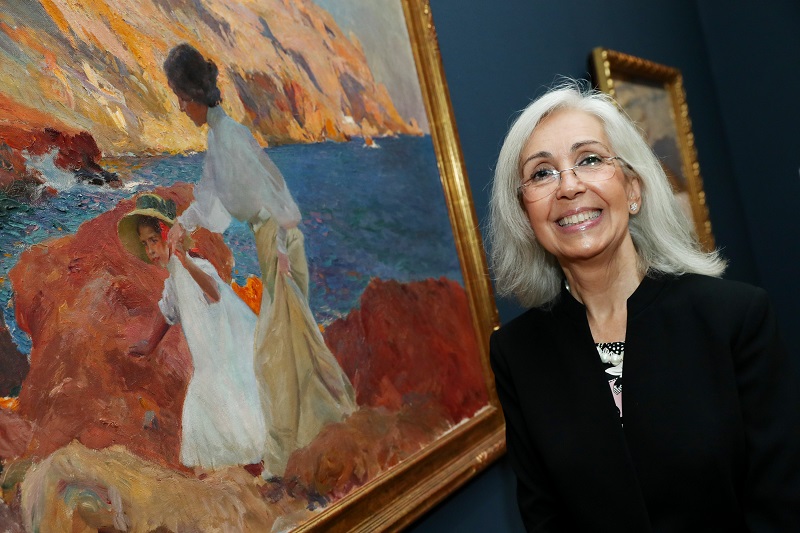
Blanca Pons Sorolla with one of her favorite paintings, one of those painted by her great-grandfather in Xàbia. "Clotilde and Elena on the rocks, Jávea" from 1905.
Wednesday 13th October 2021 – DAVID GUTIÉRREZ with Mike Smith
Blanca Pons-Sorolla Ruiz de la Prada, is the great-granddaughter of the painter Joaquín Sorolla y Bastida; she is the granddaughter of the painter’s eldest daughter, María Sorolla García and the painter Francisco Pons Arnau; she and the daughter of the marriage’s only child, Francisco Pons-Sorolla and Arnau. She is also a member of the board of trustees of the Fundación Sorolla in Madrid and recently became a patron of the Fundación Bancaja in Valencia.
She is passionate about the life and work of her great-grandfather and for this reason, she dedicates herself body and soul to continue investigating and discovering the ins and outs as well as any detail that is related to his life or any of his work. . In fact, at present, she is the only person who can certify the authenticity of a work by the painter. All this compendium of works catalogued one by one, will give shape to the reasoned catalogue of Sorolla’s pictorial work in a publication composed of four volumes, in addition to the one already published: Sorolla. Reasoned catalog. Collection of paintings from the Sorolla Museum (Ediciones El Viso, 2019). Of them, the first two will see the light soon.
But in addition to all this, Blanca Pons-Sorolla has had and still has, a special relationship with Xàbia and that is why we are going to get closer to knowing her and learning about her.
David Gutiérrez: First of all, thank you very much for taking the time to find out more about you, about your relationship with Xàbia and of course, about the work of your great-grandfather and the connection with this place.
This year Xàbia commemorates the 125th anniversary of the arrival for the first time of Sorolla and the 9 d’Octubre award has been presented to the Fundación Sorolla, an event you attended, and which marks the start of several initiatives to remember the figure of your great-grandfather in this town. How did you experience this special evening and what is your opinion of everything that is taking place?
Blanca Pons-Sorolla: Thank you very much, David. I experienced it with real emotion. We had, how could it be otherwise, a typical beautiful day in Javea with a sea, a light and a sky that made me fall in love from the first time I saw it.
The award of the “Premio 9 d´Octubre” from the Xàbia Council to the Fundación Museo Sorolla in the church square, on that starry night and with the piano concert that followed it by Marta Espinós, a worthy student of her teacher Joaquín Achúcarro, a concert that she dedicated to Sorolla on the occasion of the opening of the exhibition “Sorolla and América” in 2013, was a spectacular thing to close with.
I am deeply grateful for everything that is being done to pay tribute to Joaquín Sorolla, my dear great-grandfather, including the publication of the book dedicated to Sorolla’s stays in Jávea. And all this serves to stimulate the memory and to continue spreading the knowledge about the great artist and the great person that he was, in addition to the love he had for this land.
DG: Although you didn’t get to know your great-grandparents in person, you did get to know your grandparents María and Francisco. You have the surname Sorolla and you have grown up between canvases and family experiences of the painter. What does it mean to carry the surname Sorolla?
B: Bearing the surname Sorolla for me is a great honour, a happiness and a responsibility, as it is also bearing the first surname of my father Pons-Sorolla, which his parents joined so that he would not lose that of his grandfather. My father was also a very loving father, my great teacher and the director of the then Fundación Museo Sorolla Museum, taking over from his uncle Joaquín Sorolla García on his death in 1948, the year that I was born. We were family patrons together in 1992 of the renovated Fundación Museo Sorolla Museum, a position that he can no longer hold due to Alzheimer’s.
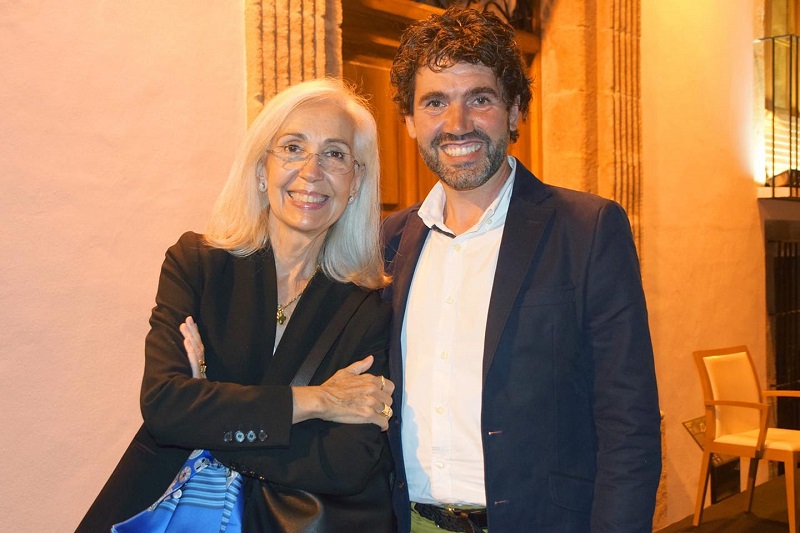
DG: When were you aware of the transcendence and importance of the figure of Sorolla in the history of art?
B: I always knew that I was a great painter, I was lucky to be born and raised in my grandparents’ house surrounded by paintings and have visited the Sorolla Museum since I was a child, which being my grandmother’s house. However, I always felt it as what was already then, the Sorolla Museum.
In addition, our house was frequently visited by visitors interested in Sorolla from the most diverse origins, which logically gave you an idea of the recognition of him.
But perhaps being aware of the importance of his figure in the history of art coincided with the change of the “nursery school” building, of the Estudio school where I was educated, “to the older ones”, on Miguel Ángel Street, very close of the Sorolla Museum, a school in which much importance was given to everything that was cultural. I was then 9 years old.
DG: What has been or is your relationship with Xàbia. When did you come here for the first time and what impression did the town make on you knowing that your great-grandfather considered Xàbia to be a paradise?
B: My first visit to Jávea was at the age of 27, already very old, and it had a great effect on me. A sister of mine had just died a year before, and to recover from so much sadness I proposed to my husband and children to spend a few days in Jávea, which I only knew through the painting of my great-grandfather and his letters. That same summer my mother wanted to come and she bought a little house with a small orange grove in Tosalet. And from there, we changed the summers in Fuenterrabía and San Sebastián for those in Jávea. There everything brought me closer to the world of my great-grandfather. And everything gave me joy and peace! That paradise that was also for Joaquín Sorolla. My children and grandchildren are now lovers of Jávea.
In the summer of 2001, 20 years ago now, I spent three months in Jávea writing the extensive biography of Joaquín Sorolla in the naya of that little house, with the smell of jasmine and the sea, contemplating pines, palm trees and orange trees. I think that if it hadn’t been for Jávea, it would have been impossible for me to write that book in such a short time.
DG: Your grandmother María appears in many pictures that Sorolla painted in Xàbia. Did she talk to you about the memories of her when she was in Xàbia as a child or perhaps did your parents transmit something to you?
B: We spent part of the summer before her death in Denia with my grandmother María. It was the first time we spent the summer in the Mediterranean, I remember the sunsets on the beach. I can’t say that she told me stories and experiences of her stays with her parents in Jávea, because I don’t remember it, but maybe if she did, I wasn’t old enough to be able to record those details.
My father came Jávea after my mother and I bought the house, but from then on until he became ill, our summers were spent in Jávea, bathing in the rocks and taking care of the garden. As we had both already read Sorolla’s letters, the memories and recollections were continuous. With him I visited “La Sultana” for the first time, and its charming owners told us the stories that their ancestors had told them. But neither as a child nor as a young man did he spend seasons in Jávea because his mother had tuberculosis and what suited her were the airs of the mountains around Madrid.
My knowledge of the life of Sorolla and his family in Jávea comes from everything I read in the letters to his wife and friends, from the chronicles of the period and from his biographies during his lifetime, in the that Sorolla collaborated with.
DG: You are now a great specialist in the work of your great-grandfather. What did Sorolla’s arrival in Xàbia mean and how did it influence the painter’s work?
B: It is evident that the dazzling work that Sorolla produced in Jávea in 1896, and which he reflects in his letters to his wife, had to be manifested in his painting, being what he was an “open-air” painter, and so it happened with El Cabo de San Antonio. Javea, which he presented at the General Exhibition of Fine Arts the following year, a work to which Blasco Ibañez dedicates a magnificent article.
His trip in 1900, after winning a Grand Prix in Paris at the World’s Fair that year, says a lot about what the light, the sea and the colour of Jávea represented for him. After having explained this to his wife in her letters from Paris as well as his desire for progress and change in his work, it is significant that he had chosen Jávea as the place to paint.
Although his variations in the use of colour had already been in place, in 1900 and especially in his works in Jávea, that change from the tonal range of his palette to a chromatic range is absolutely evident, something that in a very short time it would be final.
And for this reason, again in 1905, after his success at the Paris Salon of that year with the works Sun in the afternoon in 1903 and Summer in 1904, which had an incredible reception by the French and international press, Sorolla took the decision to present his first major retrospective in Paris the following year, and for this he needed new work. For that reason that summer of 1905 he moved to Jávea again, achieving there his greatest achievements up to that moment regarding the use of colour, the representation of light, movement, reflections and transparencies. Jávea offered him all the difficulties that he liked to face, especially with his sea, and from which he emerged triumphant. The works painted that summer dazzled in 1906 in his retrospective exhibition at the Georges Petit Gallery in Paris.
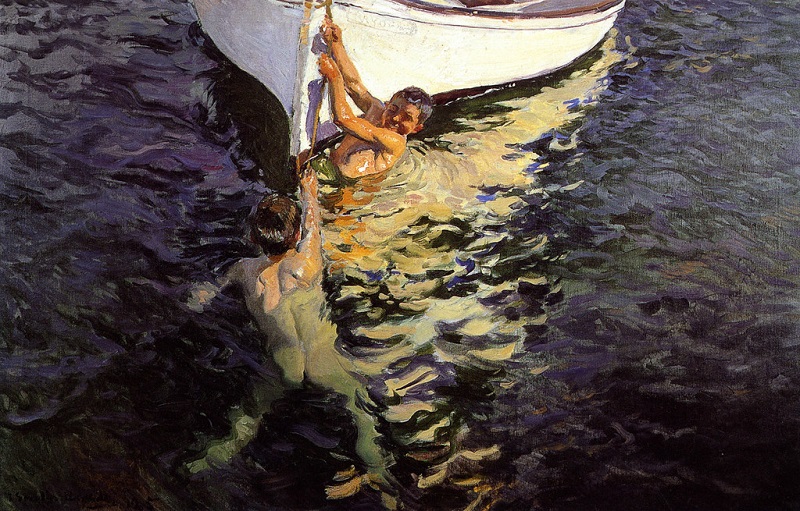
DG: Of all the work that your great-grandfather painted in Xàbia, I know it is difficult, but which painting would you choose?
B: I have to say three: The White Boat, 1905, with the two boys clinging to the anchor rope, from a private American collection, and two works of a family nature, Girls Taking the Bath. Jávea, which is kept in the Metropolitan Museum in New York and in which his wife and his daughters appear, and Clotilde and Elena on the rocks, Jávea, private collection. The three of 1905.
David Gutierrez Pulido
www.sorollajavea.wordpress.com


